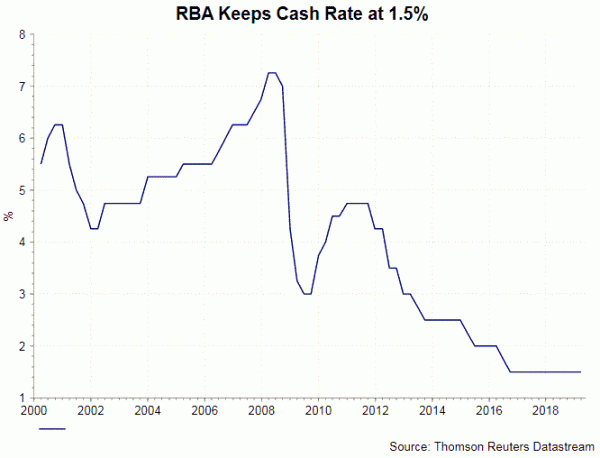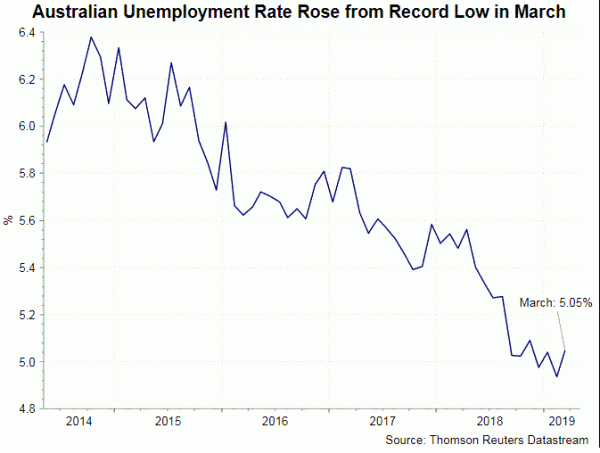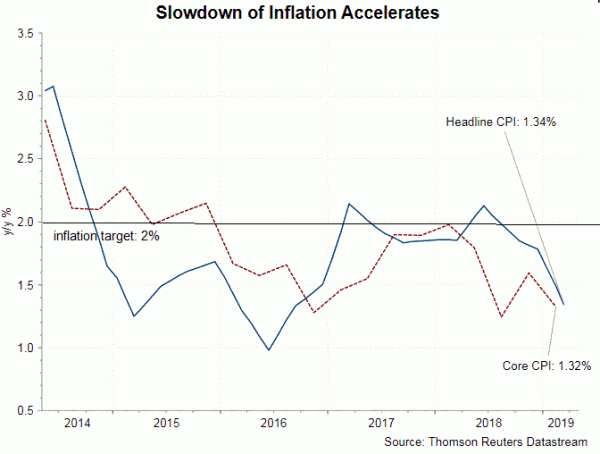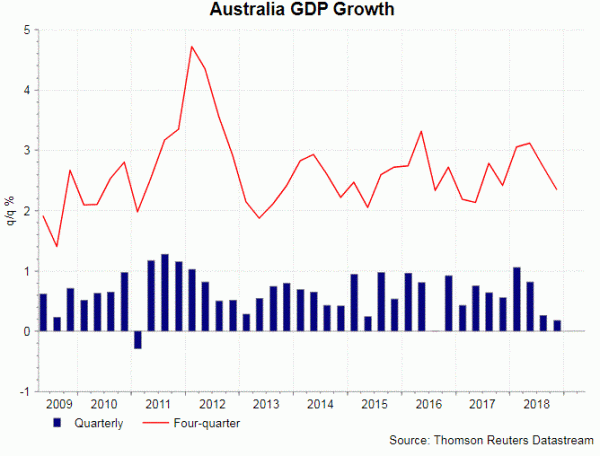RBA left the cash rate unchanged at 1.5% in May. Yet, the accompanying statement remained dovish, citing sharp deceleration in core inflation, decline in house price and subdued household consumption as key areas of concerns. On the monetary policy outlook, the members would monitor the employment situation closely, as further improvement should help lift inflation. In our opinion, it is likely that RBA would lower the policy rate if the unemployment rate climbs up to 5.2-5.5% – the levels seen in the second and third quarter of 2018. Such scenario would cause further deterioration in inflation, as well as the property market.
 Policymakers viewed more cautiously about the global and domestic economic developments. Globally, the central bank noted that “the risks are tilted to the downside”. This was compared with April’s reference that “downside risks have increased”. It indicated that inflation remained “subdued”, in contrast with April’s acknowledgement that core inflation has picked up. Regarding its largest trading partner, RBA noted that China has “taken steps to support the economy, while addressing risks in the financial system”, removing the language about China’s easing policies and slowdown in economic growth. We believe this was driven by China’s stronger-than-expected economic data for 1Q19. Depending on the trade negotiations between US and China, the headwind facing the latter’s growth slowdown could once again cause panic in Australia’s economy.
Policymakers viewed more cautiously about the global and domestic economic developments. Globally, the central bank noted that “the risks are tilted to the downside”. This was compared with April’s reference that “downside risks have increased”. It indicated that inflation remained “subdued”, in contrast with April’s acknowledgement that core inflation has picked up. Regarding its largest trading partner, RBA noted that China has “taken steps to support the economy, while addressing risks in the financial system”, removing the language about China’s easing policies and slowdown in economic growth. We believe this was driven by China’s stronger-than-expected economic data for 1Q19. Depending on the trade negotiations between US and China, the headwind facing the latter’s growth slowdown could once again cause panic in Australia’s economy.
Domestically, the major concern comes from inflation. RBA described the first quarter inflation as “noticeably lower than expected”, suggesting “subdued inflationary pressures across much of the economy”. Weak price levels have been driven by “lower housing-related costs” and policy measures “affecting administered prices”. Still, the members expect to pick up “gradually”, with the core inflation to reach +1.75% this year, +2% in 2020 and a little higher after that. Headline CPI is expected to be “around +2% this year, boosted by the recent increase in petrol prices”.
RBA retained the central scenario for GDP growth at 2.75% for 2019 and 2020. Yet, it is likely that we will see downward revisions in the upcoming Statement of Monetary Policy on Friday. The key drag on GDP growth comes from household consumption”. According to RBA, weak consumption has been “affected by a protracted period of low income growth and declining housing prices”. It forecast that “some pick-up in growth in household disposable income is expected and this should support consumption”.
Similar to other advanced economies, the job market remained resilient. While reaffirming the developments of significant increase in employment, high the vacancy rate and skills shortages in some areas, RBA is also aware of the little progress in further decline in the unemployment rate. It forecasts the unemployment rate to stay “broadly steady” at around 5% “over this time” and “remain around this level over the next year or so, before declining a little to 4.75% in 2021”
 In the forward guidance, RBA affirmed that it is “appropriate” to stand on the sideline. As future monetary policy depends on upcoming data, RBA would pay close attention to developments in the labour market as further improvement in the employment situation would help absorb spare capacity and boost inflation.
In the forward guidance, RBA affirmed that it is “appropriate” to stand on the sideline. As future monetary policy depends on upcoming data, RBA would pay close attention to developments in the labour market as further improvement in the employment situation would help absorb spare capacity and boost inflation.

















